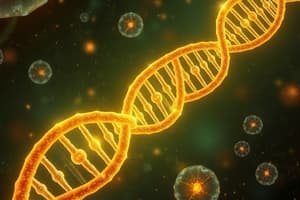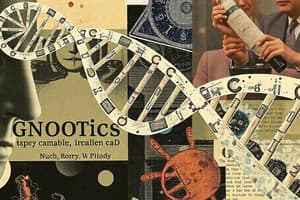Podcast
Questions and Answers
What is the result of acetylation of lysine side chains by histone acetyl transferases?
What is the result of acetylation of lysine side chains by histone acetyl transferases?
- Complete removal of positive charge from nucleosomes
- No change in the charge of nucleosomes
- Increased positive charge on nucleosomes
- Reduced positive charge on nucleosomes (correct)
What is the effect of histone deacetylases on gene transcription?
What is the effect of histone deacetylases on gene transcription?
- It activates transcription by loosening nucleosomes
- It inhibits transcription by compacting nucleosomes (correct)
- It has no effect on transcription
- It activates transcription by compacting nucleosomes
Which histone modification is associated with gene activation?
Which histone modification is associated with gene activation?
- H4 phosphorylation
- H2A ubquitination
- H3K9me
- H3K4me (correct)
What is the function of histone demethylases?
What is the function of histone demethylases?
What is the result of histone H3 lysine 9 methylation?
What is the result of histone H3 lysine 9 methylation?
What is the role of enzymes in chromatin structure regulation?
What is the role of enzymes in chromatin structure regulation?
What is the primary function of bromodomains in HATs?
What is the primary function of bromodomains in HATs?
What is the result of competition between histone acetylation and histone methylation?
What is the result of competition between histone acetylation and histone methylation?
How are histone modifications inherited by daughter cells?
How are histone modifications inherited by daughter cells?
What is the function of MeCP2 in DNA methylation?
What is the function of MeCP2 in DNA methylation?
What is the result of DNA methylation in the context of CpG islands?
What is the result of DNA methylation in the context of CpG islands?
How are histone deacetylation and DNA methylation coordinated?
How are histone deacetylation and DNA methylation coordinated?
What is the primary function of histone H3 lysine 9 methylation in chromatin compaction?
What is the primary function of histone H3 lysine 9 methylation in chromatin compaction?
Which type of elements is subject to high levels of DNA methylation?
Which type of elements is subject to high levels of DNA methylation?
What is the role of histone deacetylases in chromatin compaction?
What is the role of histone deacetylases in chromatin compaction?
What is the function of insulators in chromatin compaction?
What is the function of insulators in chromatin compaction?
How is the initiation of heterochromatin formation driven?
How is the initiation of heterochromatin formation driven?
What is the effect of cytosine methylation on gene expression?
What is the effect of cytosine methylation on gene expression?
Flashcards
Pseudogenes
Pseudogenes
Segments of DNA originating from genes, often inserted into new locations via transposons.
Repetitive sequences
Repetitive sequences
Sequences that can lead to errors in DNA repair, resulting in genomic rearrangements.
Epigenetic Modification of Histones
Epigenetic Modification of Histones
Enzymatic process that alters chromosome structure by modifying histone N-terminal tails.
Histone acetyltransferases (HATs)
Histone acetyltransferases (HATs)
Signup and view all the flashcards
Histone deacetylases (HDACs)
Histone deacetylases (HDACs)
Signup and view all the flashcards
Histone methyltransferases (HMTs)
Histone methyltransferases (HMTs)
Signup and view all the flashcards
Bromodomain
Bromodomain
Signup and view all the flashcards
DNA Methylation
DNA Methylation
Signup and view all the flashcards
CpG islands
CpG islands
Signup and view all the flashcards
Methyl-cytosine binding protein (MeCP2)
Methyl-cytosine binding protein (MeCP2)
Signup and view all the flashcards
DNA methyltransferases (DNMT)
DNA methyltransferases (DNMT)
Signup and view all the flashcards
Epigenetic Inheritance
Epigenetic Inheritance
Signup and view all the flashcards
Heterochromatin
Heterochromatin
Signup and view all the flashcards
H3K9 Methylation
H3K9 Methylation
Signup and view all the flashcards
Heterochromatin protein 1 (HP1)
Heterochromatin protein 1 (HP1)
Signup and view all the flashcards
Insulators
Insulators
Signup and view all the flashcards
Topologically associating domains (TADs)
Topologically associating domains (TADs)
Signup and view all the flashcards
H3K9 Methylases
H3K9 Methylases
Signup and view all the flashcards
Study Notes
Pseudogenes and Genome Instability
- Pseudogenes originate from genic sequences and are typically inserted into new locations via transposons.
- Repetitive sequences can cause genomic instability, leading to errors in DNA repair, which may result in inversions and deletions.
- An example of genome rearrangement is Williams Syndrome, which exhibits specific physical traits and sociable behavior.
Epigenetic Modification of Histones
- Enzymatic regulation of chromosome structure involves modifying histone N-terminal tails through acetylation, methylation, phosphorylation, and ubiquitination.
- Histone acetyl transferases (HATs) acetylate lysine side chains, reducing their positive charge. This promotes an open chromatin conformation, facilitating transcription factor access.
- Acetylation of lysines forms an amide bond, similar to peptide bonds.
- Histone deacetylases (HDACs) remove acetyl groups, leading to compact nucleosome packaging and repression of transcription.
- Histone methyltransferases (HMTs) add methyl groups to lysines, resulting in activating (e.g., H3K4me) or inhibiting (e.g., H3K9me) modifications.
- Lysines can be modified by mono-, di-, or tri-methylation, and specific enzymes demethylate these sites.
- Many HATs and HMTs must recognize their modification products, with HATs often containing bromodomains that specifically recognize acetylated histones.
- Competition exists between acetylation and methylation at specific histone positions, creating a complex regulatory landscape.
- Histone modifications can be epigenetically inherited by daughter cells, thus not being encoded in the DNA sequence.
DNA Methylation
- DNA can undergo methylation, primarily at cytosines, which is considered an epigenetic modification due to its heritable nature.
- Cytosine is often methylated at the 5' position within CpG sequences, typically clustered into "CpG islands."
- Proteins like methyl-cytosine binding protein (MeCP2) bind to methylated cytosines and recruit DNA methyltransferases (DNMT) to propagate the modification.
- DNA methylation is interrelated with histone modifications; for example, MeCP2 also recruits histone deacetylases.
- Methylation is commonly found in gene promoter regions and is associated with gene repression.
- Repetitive elements, particularly transposable elements, experience high levels of methylation, contributing to their repression.
Chromatin Compaction and Epigenetic Modifications
- Heterochromatin compaction is reliant on specific epigenetic modifications, particularly H3K9 methylation.
- H3K9me serves as a binding site for heterochromatin protein 1 (HP1), a reader protein that recruits various modifying enzymes.
- The spreading of these modifications can lead to local chromatin compaction and inactivation of adjacent genes.
- Insulators located at topologically associating domain (TAD) boundaries can suppress the lateral spread of modifications through steric disruption.
- Heterochromatin formation can be initiated by DNA binding proteins or the production of double-stranded RNA from repeats, leading to recruitment of H3K9 methylases.
Studying That Suits You
Use AI to generate personalized quizzes and flashcards to suit your learning preferences.



